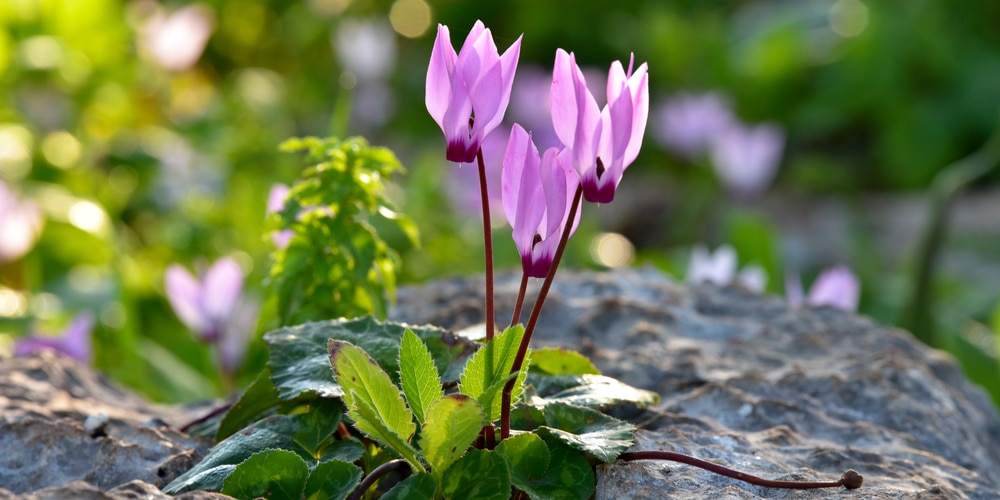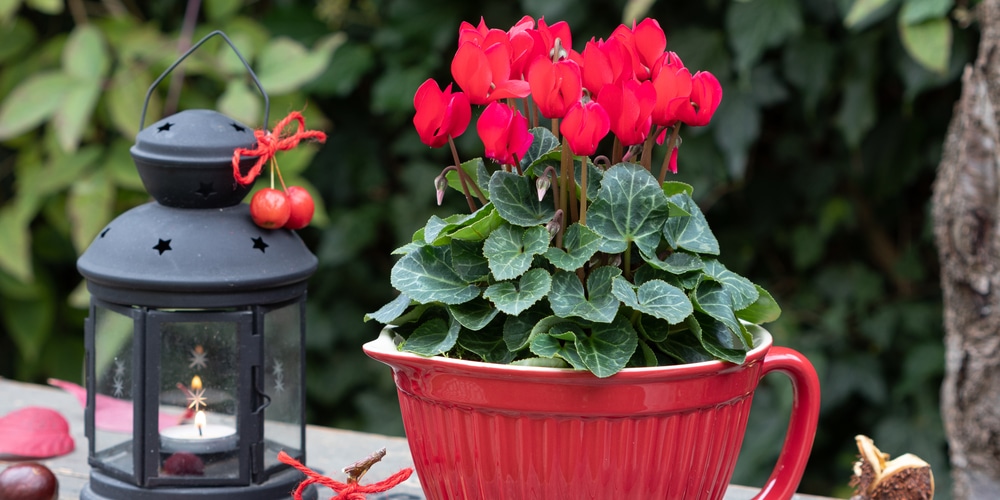miteCyclamen plants make excellent houseplants, blooming cheerfully in the fall, winter, and early spring. While most varieties of cyclamens are planted during this period for their beautiful blooms, gardeners who live in warmer climates may be able to enjoy this flowering perennial throughout the year.
The best known cyclamens are those produced for Easter and Christmas, but many other varieties flower in between these festivities. Let’s look at how to grow and care for a Cyclamen plant.
What is a Cyclamen?
Cyclamen plants have the botanical name Cyclamen persicum and are lovely flowering plants. It has been popular in gardens across Europe and the USA for hundreds of years and can also be grown as a houseplant. These plants are part of the Primulaceae family and can be planted outdoors in USDA zones 9 to 11.
A Cyclamen plant is more commonly kept as a house plant and consists of a tuber, like an onion from which leaves and flowers grow in the fall, winter, and spring. Blooms can last for between 6 to 12 weeks. The flowers come in a wide range of colors from white, pinks to reds and purples with attractively marked leaves in shades of green through silver and russet. Newer hybrids have more detailed foliar markings in contrasting or complementary colors.
Once the Cyclamen has finished blooming, the plant will die back completely and regrow again the following year.
Cyclamen Care Indoors
The Cyclamen plant does well in the average home – not too hot and not too cold. Temperature and humidity is probably the most important point about its care. It also needs bright light, but not direct sunlight. Too much sunlight may cause the leaves to curl or turn brown along the edges. Here are some tips to help you grow a healthy Cyclamen plant:
Sunlight Needs
Cyclamen plants do best with bright light but not direct sunlight. When the plant is finished flowering, cut back on watering and move it away from windows or other sources of strong sun. Cyclamen have their growing season in the fall to spring and will become dormant in summer. During dormancy, they can be moved to a cool, dark place.
Watering requirements
Cyclamen plants need plenty of water while it is actively growing. You can test your plant’s soil and water it when the top 1 inch of soil feels dry. After flowering is finished, it should be kept slightly drier with only enough water to keep the soil from drying out completely between waterings.
The frequency of watering will depend upon how hot your home is and the humidity levels. Hot, sunny conditions or drafty areas will require more frequent watering than cool, shady areas.
Fertilization
Feed every one to two months during the growing season with a balanced fertilizer such as 20-20-20 diluted to half strength. Be careful not to overfeed your plant, or its roots may suffer from root burn due to over-exposure to chemicals.
Temperature and humidity
Cyclamen plants do not like hot temperatures. They grow best in a temperature that ranges from 60 to 75 degrees F during the day and 50 to 60 degrees F at night.
Humidity levels should be moderate, between 40% and 70%. If the humidity is too low, use a humidity tray or room humidifier near your plant. It’s particularly important to increase humidity around your cyclamen plant in the winter when it is actively growing. You can mist your plant’s leaves but be careful not to soak the foliage or flower as this could cause fungal infections. To avoid this, use a fine mist spray bottle in the morning so that any excess water has time to evaporate during the day.
Pruning
Pinching out spent flowers will help promote further blooms, although this can produce rather spindly side shoots in some varieties; in others, it won’t make much difference. You can also pinch off dead or damaged foliage. If your plant is getting too large, you may like to prune it slightly to the desired shape and size.
Soil
Use a well-drained, peat-based compost as this is most like the soil in which cyclamen tubers form naturally. These plants do well in soils that are loamy and moist. A small plastic pot can be used as long as it has drainage holes and good quality compost. The plant pot doesn’t need to be too big or deep, just wide enough for the leaves and flowers with a depth of about 5 inches (12cm). A diameter of 4 inches (10cm) is fine. Cyclamen plants like soil that’s slightly acidic and has a pH range of between 5.0 and 6.5.
Pests and diseases
Cyclamen plants are particularly susceptible to Cyclamen Mites, which are so small that they can be carried by larger insects. If you see little raised, white or green dots on the undersides of leaves, your plant may be infested with Cyclamen Mites. These mites are very hard to detect as they are just 1mm in size and are hard to see without using a magnifying glass.
Cyclamen plants can also be affected by other sap-sucking insects, including aphids, mealybugs, and spider mites. To control insect infestation, use an appropriate pesticide according to manufacturers’ instructions.
Cyclamen Varieties
There are many types of Cyclamen plants available, including the strongly fragranced Scentsation with its pink and red flowers. The Victoria cyclamen has white flowers with red tinges, while the Sierra series have larger flowers that can grow up to three inches in diameter and are salmon, pink, white, purple, or lilac. All of these varieties do well in a winter hanging basket.
Conclusion
Now that you understand how to care for your cyclamen, enjoy this beautiful plant. It does well as a potted houseplant or as a border plant as long as you follow the important points of care. A thriving cyclamen will look beautiful and, you should have plenty of delightful blooms throughout the year. These plants are perfect for a winter garden as many varieties have flowers around the holiday season.

